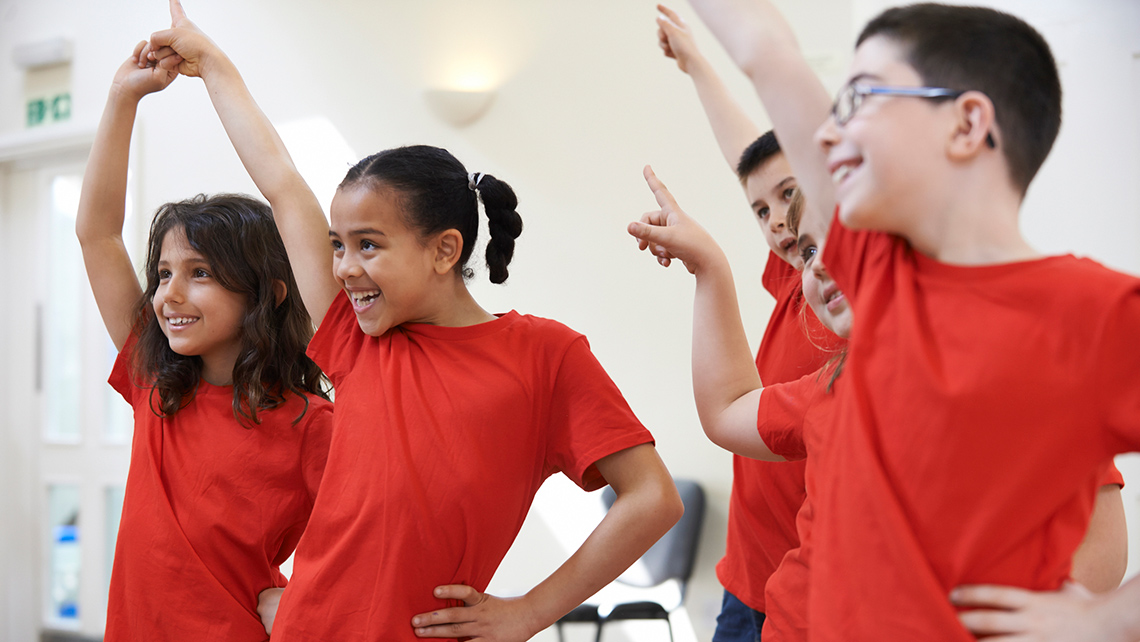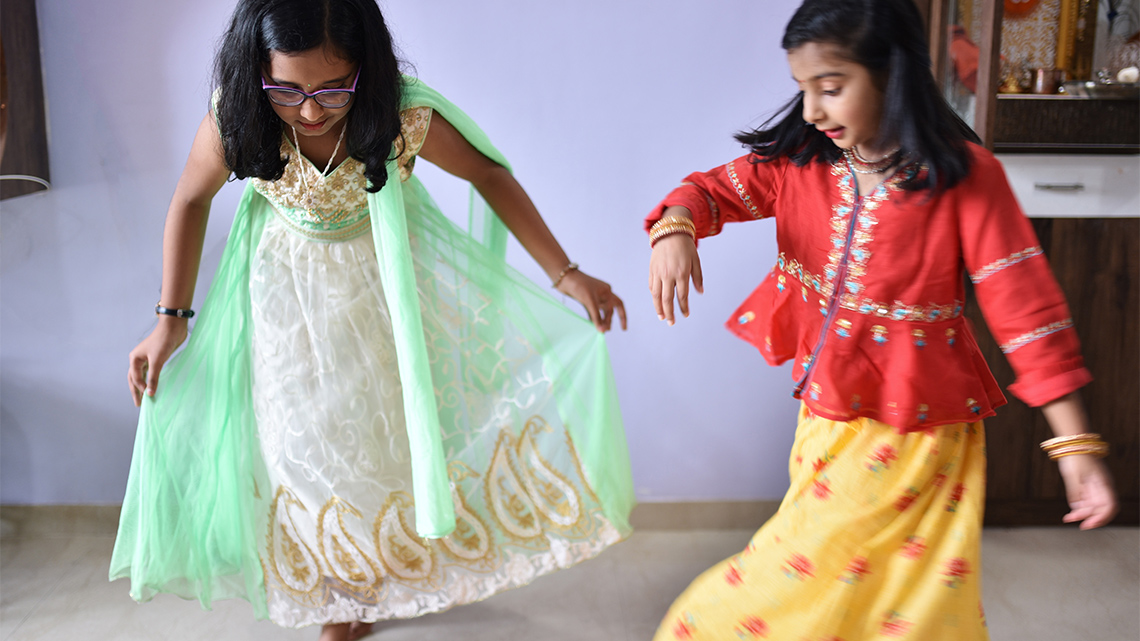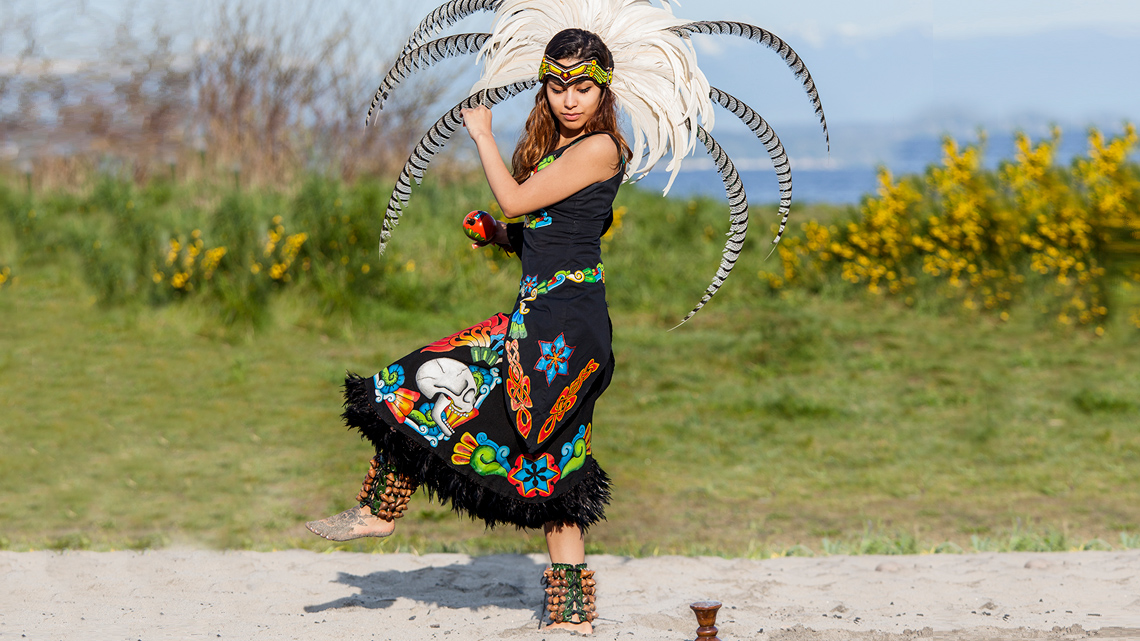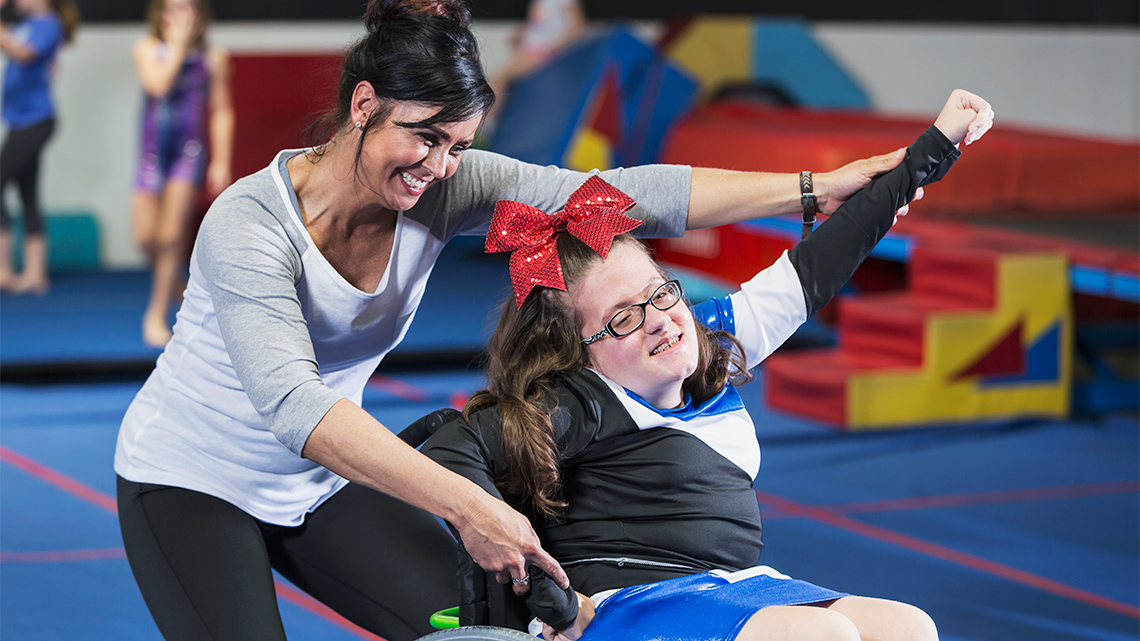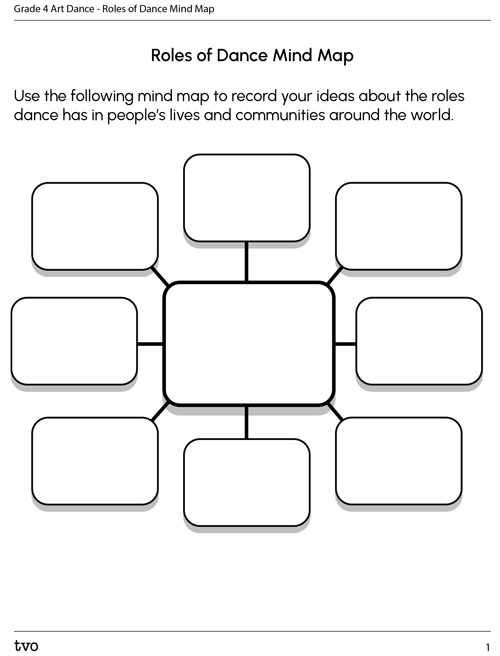Minds On
Today’s vocabulary
Press the following tabs to access the definitions for today’s vocabulary.
Let’s get started!
Examine the following images and descriptions of people dancing and consider the following question.
Why do you think people dance?
Record your ideas using a method of your choice.
Action
Get ready, get set…

Tabanan dancer
A child from Tabanan, Indonesia making a dance pose while wearing a traditional dance attire and holding an artifact decorated with flowers made with fabric and beads dangling from the middle. The dancer is wearing a head piece with floral decorations and a traditional neck piece, dress, and jewellery. The dancer has their body slightly leaning to one side, and their arms are bent with elbows pointing to opposite directions. The dancer’s hand that is free is extended and pointing upwards. Other dancers are getting ready in the background.
Dance has many roles in people’s lives and communities around the world.
What might be some of these roles of dance? Use the following mind map provided to organize your ideas or record your answers using a method of your choice.
Portfolio
Portfolio
Complete the Roles of Dance Mind Map in your notebook or using the following fillable and printable document to record your ideas about the different roles dance has in people’s lives and communities around the world. If you would like, you can use speech-to-text or audio recording tools to record your thoughts. Consider adding your work to your portfolio.
After you have recorded your ideas, press the ‘Answer’ button to examine different roles that dance can have in a person’s life and community.
The roles of dance in a person’s life and community can include the following:
- to socialize
- for entertainment
- to communicate and tell stories
- to boost the school or community experience through clubs, classes, performances
- to celebrate a good harvest year
- as part of a religious ceremony
Dance and culture
In some cultures, people dance to celebrate a good harvest year. Some communities perform dances as a part of their religious ceremonies.
Dance is very important to cultures all over the world. In First Nations, Métis, and Inuit cultures dance is used for celebration, ceremony, and for entertainment. However, in the past, Indigenous dances were banned from being practised as it was identified as different than European society.
For decades, Indigenous peoples, specifically First Nations individuals, were not allowed to wear their regalia, perform using traditional instruments, or gather in groups to celebrate, mourn, heal, or have fun together. Despite this history, Indigenous peoples continued to practise their dances and today they are still performed across Turtle Island.

Dance has deep meanings within Indigenous communities. Each dance carries specific teachings and histories with it. The Hoop dance was historically a healing dance meant to help those who were sick in the community. The dancer tells a story of the never-ending circle of life with their movements. Today, the dance is performed to celebrate and remind people of their teachings and to inspire them to have pride in their identities. Each dancer has unique moves and regalia based on the nation and community they come from. In some families, Hoop dancing is passed down from generation to generation.
In the following two videos, Emily and Alexciia share some of their teachings around the hoop dance.
Emily is Mohawk from Montreal, Québec and Alexciia is Blackfoot from Calgary, Alberta.
The Hoop dance is performed in many communities and each community may have slightly different teachings around the Hoop dance. As dances travel, they can take on new meanings and styles.
Access the following video from the TVO show Raven’s Quest to learn more about Emily and Hoop dancing.
Now, let’s explore the following video with another episode of Raven’s Quest to learn more about Alexciia and Hoop dancing.
The Hoop dance is not a dance to copy or imitate but to be appreciated. First Nations, Métis, and Inuit dances are linked to cultural identity and pride. For First Nations, the Hoop dance, and the teachings it carries with it are sacred.
Check your understanding!
Use your learning to state whether the following four statements about the role of dancing are true or false. For each statement, select the correct answer, then press the ‘Check Answer’ button to find out how you did.
Dance in a community
Let’s examine a different role that dance may have in a community.
Explore the following video to learn about a dance in a community in Eastern Ontario.
In the Step into Motion dance festival example, several dance community members come together to share their passion for dance.
Press the following tabs to learn more about the Step into Motion dance festival and its importance in the community.
The role of dance in this community takes many forms.
It is a discipline and subject being taught in school and as a platform used to share ideas, inspire others, and remain active.
Many elementary and high schools come together to share their love of dance and present what they have practised all year in their dance clubs.
This festival aims to promote dance in the school and the community in Eastern Ontario. The festival includes schools, dance studios, and even professional dancers. The video you examined includes professional dance companies and dancers, school performances, and workshops for dancers. This festival lasts for three to four days.
Pause and Reflect
Pause and reflect
Consider the following questions:
- Do you have dance events or dance related activities in your community?
- Where have you experienced or explored dance before?
Record your responses using a method of your choice. Consider adding your work to your portfolio.
Go!
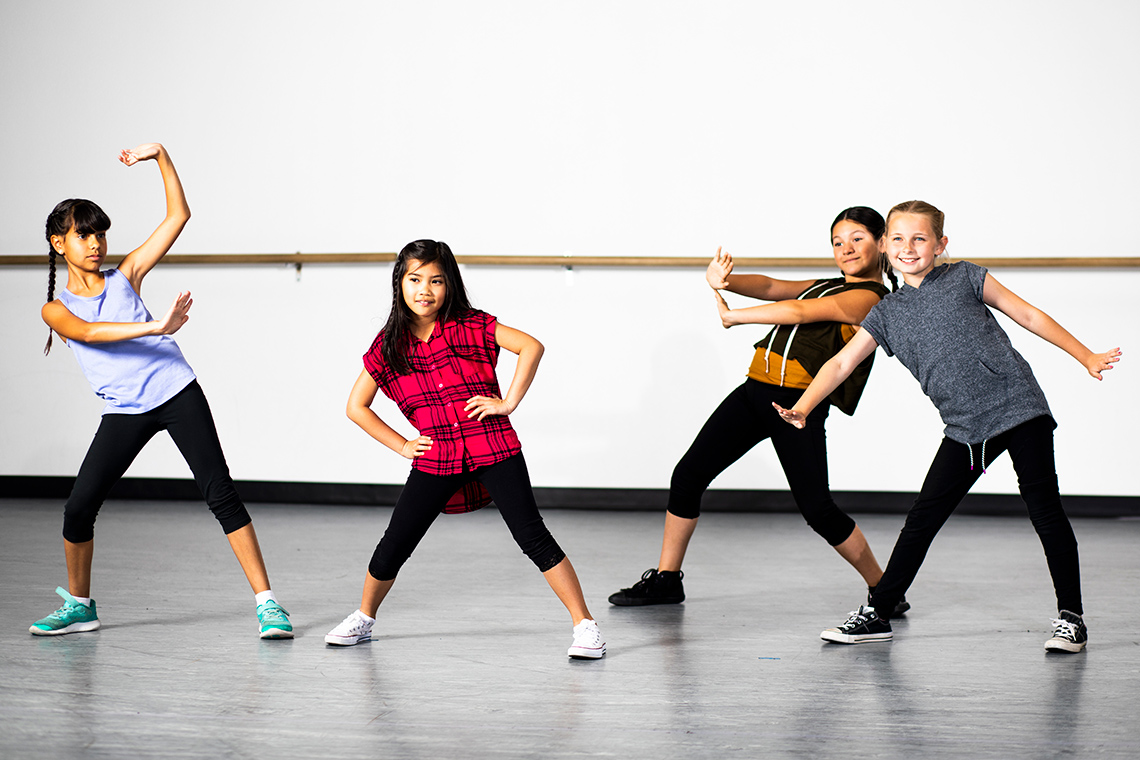
The role of dance can change depending on the community. Dance can have a healing purpose, be used for celebrations or rituals, bring people together to celebrate, perform and showcase different dance styles.
Let’s think back to the Step into Motion festival.
Step into Motion began with organizing a dance club in a high school. The students needed support from other team players, like principals, teachers, and community leaders to get such a project going. They had to convince them that a dance program in their high school was important.
The Step into Motion program had many roles within this school community and the larger community of Eastern Ontario. The roles of dance in this community included the following:
- It provided students with an opportunity to experience the art of dance.
- It allowed students to share stories through dance.
- It gave the students an opportunity to socialize with other dancers.
- It opened students’ understanding of dance by including a variety of dance forms from around the world.
- It gave many students and community members a chance to come to their performances.
These students and teachers created a pitch to highlight these benefits of dance in their schools.
A pitch is a way to convince people to support a project. It can take the form of a presentation, a flyer, or a short podcast aimed at a specific audience. It explains an idea. In this case, it is a dance club in the school that results in a dance festival.
Now, it’s your turn to create a pitch to highlight the importance of dance in your school or community.
Choose one of the following options to create your pitch.
Option 1: Pitching to a community

Create a pitch that convinces your community to have a dance club. You may create a flyer, slidedeck presentation, podcast, or use another method of your choice.
Consider the following questions:
- Why should the community have a dance program like Step into Motion?
- Which roles of dance would you like to include in your pitch?
Use the following checklist to select all the roles you would like to include.
Roles of dance
The roles of dance in a person's life and community include:
As you think about what roles of dance you would like to include in your pitch to a community member, revisit the roles of dance experienced by those who were involved in Step into Motion.
Record your pitch as a flyer, slidedeck presentation, podcast, or use another method of your choice. Consider adding your work to your portfolio.
Option 2: Pitching to a school

Create a pitch that convinces the administrators of a school to have a dance club. You may create a flyer, slidedeck presentation, podcast, or use another method of your choice.
Consider the following questions:
- Why should your school have a dance program like Step into Motion?
- Which roles of dance would you like to include in your pitch?
Use the following checklist to select all the roles you would like to include.
Roles of dance
The roles of dance in a person's life and community include:
As you think about what roles of dance you would like to include in your pitch to a school administrator, revisit the roles of dance experienced by those who were involved in Step into Motion.
Record your pitch as a flyer, Pslidedeck presentation, podcast, or use another method of your choice. Consider adding your work to your portfolio.
Consolidation
Putting it all together

Portfolio
Review your learning
If possible, share your final pitch with someone or record it.
Use the following questions to reflect on your learning.
- What did you learn about the role of dance in your life or in different communities?
- Why is dance important and what impact does it have?
- Can you identify and describe the different roles that dance might have?
- What did you learn by making a pitch for a dance club in a school or community?
Record your response with a method of your choice. Consider adding your work to your portfolio.
Reflection
As you read through these descriptions, which sentence best describes how you are feeling about your understanding of this learning activity? Press the button that is beside this sentence.
I feel…
Now, record your ideas using a voice recorder, speech-to-text, or writing tool.
